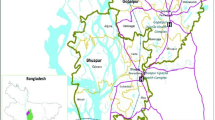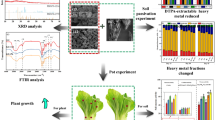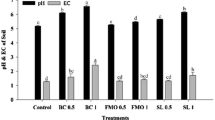Abstract
The opposed transformation of arsenic (As) and cadmium (Cd) in paddy soil postures numerous challenges for their simultaneous remediation. An incubation study was conducted on the immobilization of Cd and As by biochar (BC), goethite (G), goethite-combined biochar (BC + G), and goethite-modified biochar (GBC). The results showed that biochar effectively immobilized Cd while significantly increasing As mobility, whereas goethite effectively immobilized As more than Cd. BC + G treatment significantly decreased toxicity characteristics leaching procedure (TCLP) and CaCl2-extractable Cd by 22.70% and 40.15%; meanwhile, TCLP and NaHCO3-As were significantly reduced by 38.25% and 31.87%, respectively, compared with the control. This study found that GBC was the optimum amendment within the immobilization efficiency for CaCl2-Cd (57.03%) and TCLP-As (61.11%). BC + G and GBC applications showed some interactions between biochar and goethite, which played an essential role in immobilizing Cd and As simultaneously. Therefore, GBC showed a great benefit in being a low-cost and efficient environmental amendment for Cd and As remediation in alkaline co-contaminated paddy soil.





Similar content being viewed by others
Data availability
All data are included within the manuscript.
References
Ahmad M, Rajapaksha AU, Lim JE, Zhang M, Bolan N, Mohan D, Vithanage M, Lee SS, Ok YS (2014) Biochar as a sorbent for contaminant management in soil and water: a review. Chemosphere 99:19–33
Ali U, Shaaban M, Bashir S, Gao R, Fu Q, Zhu J, Hu H (2020) Rice straw, biochar and calcite incorporation enhance nickel (Ni) immobilization in contaminated soil and Ni removal capacity. Chemosphere 244:125418
Asmel NK, Yusoff AR, Krishna LS, Majid ZA, Salmiati S (2017) High concentration arsenic removal from aqueous solution using nano-iron ion enrich material (NIIEM) super adsorbent. Chem Eng J 317:343–355
Baragaño D, Alonso J, Gallego JR, Lobo MC, Gil-Díaz M (2020) Zero valent iron and goethite nanoparticles as new promising remediation techniques for As-polluted soils. Chemosphere 238:124624. https://doi.org/10.1016/j.chemosphere.2019.124624
Bashir S, Hussain Q, Shaaban M, Hu H (2018) Efficiency and surface characterization of different plant derived biochar for cadmium (Cd) mobility, bioaccessibility and bioavailability to Chinese cabbage in highly contaminated soil. Chemosphere 211:632–639
Bashir S, Hussain Q, Jun ZH, Qingling FU, Houben D, Hongqing HU (2020) Efficiency of KOH-modified rice straw-derived biochar for reducing cadmium mobility, bioaccessibility and bioavailability risk index in red soil. Pedosphere 30:874–882
Bundschuh J, Bhattacharya P, Sracek O, Mellano MF, Ramírez AE, Storniolo AD, Martín RA, Cortes J, Litter MI, Jean JS (2011) Arsenic removal from groundwater of the Chaco-Pampean plain (Argentina) using natural geological materials as adsorbents. J Environ Sci Heal Part A 46:1297–1310
Carré F, Caudeville J, Bonnard R, Bert V, Boucard P, Ramel M (2017) Soil contamination and human health: a majr challenge for global soil security. Global Soil Security. Springer, pp 275–295.
Chen B, Chen Z, Lv S (2011) A novel magnetic biochar efficiently sorbs organic pollutants and phosphate. Bioresour Technol 102:716–723
Choppala G, Bolan N, Kunhikrishnan A, Bush R (2016) Differential effect of biochar upon reduction-induced mobility and bioavailability of arsenate and chromate. Chemosphere 144:374–381
Cui H, Yang X, Xu L, Fan Y, Yi Q, Li R, Zhou J (2017) Effects of goethite on the fractions of Cu, Cd, Pb, P and soil enzyme activity with hydroxyapatite in heavy metal-contaminated soil. RSC Adv 7:45869–45877. https://doi.org/10.1039/c7ra08786a
Cui L, Noerpel MR, Scheckel KG, Ippolito JA (2019) Wheat straw biochar reduces environmental cadmium bioavailability. Environ Int 126:69–75
Fan J, Chen X, Xu Z, Xu X, Zhao L, Qiu H, Cao X (2020) One-pot synthesis of nZVI-embedded biochar for remediation of two mining arsenic-contaminated soils: arsenic immobilization associated with iron transformation. J Hazard Mater 398:122901. https://doi.org/10.1016/j.jhazmat.2020.122901
Gao R, Hu H, Fu Q, Li Z, Xing Z, Ali U, Zhu J, Liu Y (2020) Remediation of Pb, Cd, and Cu contaminated soil by co-pyrolysis biochar derived from rape straw and orthophosphate: speciation transformation, risk evaluation and mechanism inquiry. Sci Total Environ 730:139119. https://doi.org/10.1016/j.scitotenv.2020.139119
Ge X, Ma Y, Song X, Wang G, Zhang H, Zhang Y, Zhao H (2017) β-FeOOH nanorods/carbon foam-based hierarchically porous monolith for highly effective arsenic removal. ACS Appl Mater Interfaces 9:13480–13490
Ghanbariasad A, Taghizadeh SM, Show PL, Nomanbhay S, Berenjian A, Ghasemi Y, Ebrahiminezhad A (2019) Controlled synthesis of iron oxyhydroxide (FeOOH) nanoparticles using secretory compounds from Chlorella vulgaris microalgae. Bioengineered 10:390–396. https://doi.org/10.1080/21655979.2019.1661692
Granados-Correa F, Corral-Capulin NG, Olguín MT, Acosta-León CE (2011) Comparison of the Cd (II) adsorption processes between boehmite (γ-AlOOH) and goethite (α-FeOOH). Chem Eng J 171:1027–1034
Guo X, Ge J, Yang C, Wu R, Dang Z, Liu S (2015) Sorption behavior of tylosin and sulfamethazine on humic acid: kinetic and thermodynamic studies. Rsc Adv 5:58865–58872
Guo Y, Li X, Liang L, Lin Z, Su X, Zhang W (2021) Immobilization of cadmium in contaminated soils using sulfidated nanoscale zero-valent iron: effectiveness and remediation mechanism. J Hazard Mater 420:126605. https://doi.org/10.1016/j.jhazmat.2021.126605
Hartley W, Lepp NW (2008) Effect of in situ soil amendments on arsenic uptake in successive harvests of ryegrass (Lolium perenne cv Elka) grown in amended As-polluted soils. Environ Pollut 156:1030–1040
Hendershot WH, Lalande H, Duquette M (2008). Chapter 18. Ion exchange and exchangeable cations. Soil Sampl. methods Anal. Boca Rat. Can. Soc. Soil Sci. CRC Press. p 173–178.
Irshad MK, Chen C, Noman, Ibrahim M, Adeel M, Shang J (2020a) Goethite-modified biochar restricts the mobility and transfer of cadmium in soil-rice system. Chemosphere 242:125152
Irshad MK, Noman A, Alhaithloul HAS, Adeel M, Rui Y, Shah T, Zhu S, Shang J (2020) Goethite-modified biochar ameliorates the growth of rice (Oryza sativa L.) plants by suppressing Cd and As-induced oxidative stress in Cd and As co-contaminated paddy soil. Sci Total Environ 717:137086. https://doi.org/10.1016/j.scitotenv.2020.137086
Jiang J, Xu R, Jiang T, Li Z (2012) Immobilization of Cu (II), Pb (II) and Cd (II) by the addition of rice straw derived biochar to a simulated polluted Ultisol. J Hazard Mater 229:145–150
Kayan B, Kalderis D, Kulaksız E, Gözmen B (2017) Adsorption of malachite green on Fe-modified biochar: influencing factors and process optimization. Desalin Water Treat 74:383–394
Legodi MA, de Waal D (2007) The preparation of magnetite, goethite, hematite and maghemite of pigment quality from mill scale iron waste. Dye Pigment 74:161–168. https://doi.org/10.1016/j.dyepig.2006.01.038
Li G, Khan S, Ibrahim M, Sun TR, Tang JF, Cotner JB, Xu YY (2018) Biochars induced modification of dissolved organic matter (DOM) in soil and its impact on mobility and bioaccumulation of arsenic and cadmium. J Hazard Mater 348:100–108
Li J, Liang N, Jin X, Zhou D, Li H, Wu M, Pan B (2017) The role of ash content on bisphenol A sorption to biochars derived from different agricultural wastes. Chemosphere 171:66–73
Li Y, Wen J, Shen P, Zhou Y, Shen J, Jiang J, Kong X, Gu X (2020) Comparison of four amendments for arsenic and cadmium combined contaminated soil. Bull Environ Contam Toxicol 105:639–644. https://doi.org/10.1007/s00128-020-02995-7
Liu L, Li W, Song W, Guo M (2018) Remediation techniques for heavy metal-contaminated soils: Principles and applicability. Sci Total Environ 633:206–219
Liu P, Liu WJ, Jiang H, Chen JJ, Li WW, Yu HQ (2012) Modification of bio-char derived from fast pyrolysis of biomass and its application in removal of tetracycline from aqueous solution. Bioresour Technol 121:235–240
Luo M, Lin H, He Y, Zhang Y (2020) The influence of corncob-based biochar on remediation of arsenic and cadmium in yellow soil and cinnamon soil. Sci Total Environ 717:137014. https://doi.org/10.1016/j.scitotenv.2020.137014
Meng J, Zhong L, Wang L, Liu X, Tang C, Chen H, Xu J (2018) Contrasting effects of alkaline amendments on the bioavailability and uptake of Cd in rice plants in a Cd-contaminated acid paddy soil. Environ Sci Pollut Res 25:8827–8835
MEP, MLR (2014) The National Soil Contamination Survey. pp 1–5.
Mitzia A, Vítková M, Komárek M (2020) Assessment of biochar and/or nano zero-valent iron for the stabilisation of Zn, Pb and Cd: a temporal study of solid phase geochemistry under changing soil conditions. Chemosphere 242:125248. https://doi.org/10.1016/j.chemosphere.2019.125248
Mohamed I, Zhang GS, Li ZG, Liu Y, Chen F, Dai K (2015) Ecological restoration of an acidic Cd contaminated soil using bamboo biochar application. Ecol Eng 84:67–76
Naseri E, Reyhanitabar A, Oustan S, Heydari AA, Alidokht L (2014) Optimization arsenic immobilization in a sandy loam soil using iron-based amendments by response surface methodology. Geoderma 232–234:547–555. https://doi.org/10.1016/j.geoderma.2014.06.009
Niu L, Yang F, Xu C, Yang H, Liu W (2013) Status of metal accumulation in farmland soils across China: from distribution to risk assessment. Environ Pollut 176:55–62
Palansooriya KN, Shaheen SM, Chen SS, Tsang DCW, Hashimoto Y, Hou D, Bolan NS, Rinklebe J, Ok YS (2020) Soil amendments for immobilization of potentially toxic elements in contaminated soils: a critical review. Environ Int 134:105046
Qiao JT, Liu TX, Wang XQ, Li FB, Lv YH, Cui JH, Zeng XD, Yuan YZ, Liu CP (2018) Simultaneous alleviation of cadmium and arsenic accumulation in rice by applying zero-valent iron and biochar to contaminated paddy soils. Chemosphere 195:260–271. https://doi.org/10.1016/j.chemosphere.2017.12.081
Qiao J, Yu H, Wang X, Li F, Wang Q, Yuan Y, Liu C (2019) The applicability of biochar and zero-valent iron for the mitigation of arsenic and cadmium contamination in an alkaline paddy soil. Biochar 1:203–212. https://doi.org/10.1007/s42773-019-00015-4
Salam A, Bashir S, Khan I, Rizwan MS, Chhajro MA, Feng X, Zhu J, Hu H (2018) Biochars Immobilize lead and copper in naturally contaminated soil. Environ Eng Sci 35:1349–1360. https://doi.org/10.1089/ees.2018.0086
Satarug S, Moore MR (2004) Adverse health effects of chronic exposure to low-level cadmium in foodstuffs and cigarette smoke. Environ Health Perspect 112:1099–1103
Singh R, Singh S, Parihar P, Singh VP, Prasad SM (2015) Arsenic contamination, consequences and remediation techniques: a review. Ecotoxicol Environ Saf 11:247–270
Suda A, Makino T (2016) Functional effects of manganese and iron oxides on the dynamics of trace elements in soils with a special focus on arsenic and cadmium: a review. Geoderma 270:68–75
Sun Z, Chen J (2018) Risk assessment of potentially toxic elements (PTEs) pollution at a rural industrial wasteland in an abandoned metallurgy factory in North China. Int J Environ Res Public Health 15:85
Tang J, Zhu W, Kookana R, Katayama A (2013) Characteristics of biochar and its application in remediation of contaminated soil. J Biosci Bioeng 116:653–659
Tuček J, Prucek R, Kolařík J, Zoppellaro G, Petr M, Filip J, Sharma VK, Zbořil R (2017) Zero-valent iron nanoparticles reduce arsenites and arsenates to As(0) firmly embedded in core-shell superstructure: challenging strategy of arsenic treatment under anoxic conditions. ACS Sustain Chem Eng 5:3027–3038. https://doi.org/10.1021/acssuschemeng.6b02698
USEPA (1992) EPA Method 1311. TCLP-toxicity characteristic leaching procedure. In USEPA (ed.) Test Methods for Evaluating Solid Waste. 3rd Edn. Environmental Protection Agency, Washington, D.C. pp 1–35.
Wan X, Li C, Parikh SJ (2020) Simultaneous removal of arsenic, cadmium, and lead from soil by iron-modified magnetic biochar. Environ Pollut 261:114157. https://doi.org/10.1016/j.envpol.2020.114157
Wang N, Xue XM, Juhasz AL, Chang ZZ, Li HB (2017) Biochar increases arsenic release from an anaerobic paddy soil due to enhanced microbial reduction of iron and arsenic. Environ Pollut 220:514–522
Wang S, Gao B, Zimmerman AR, Li Y, Ma L, Harris WG, Migliaccio KW (2015) Removal of arsenic by magnetic biochar prepared from pinewood and natural hematite. Bioresour Technol 175:391–395
Wang YM, Wang SW, Wang CQ, Zhang ZY, Zhang JQ, Meng M, Li M, Uchimiya M, Yuan AXY (2020) Simultaneous immobilization of soil Cd(II) and As(V) by Fe-modified biochar. Int J Environ Res Public Health 17:827. https://doi.org/10.3390/ijerph17030827
Waychunas GA, Kim CS, Banfield JF (2005) Nanoparticulate iron oxide minerals in soils and sediments: unique properties and contaminant scavenging mechanisms. J Nanoparticle Res 7:409–433
World Health Organization, 2011. Cadmium in drinking-water. Available at: http:// www.who.int/water_sanitation_health/dwq/chemicals/cadmium.pdf.
Wu C, Cui MQ, Xue SG, Li WC, Huang L, Jiang XX, Qian ZY (2018) Remediation of arsenic-contaminated paddy soil by iron-modified biochar. Environ Sci Pollut Res 25:20792–20801. https://doi.org/10.1007/s11356-018-2268-8
Yang D, Yang S, Wang L, Xu J, Liu X (2021) Performance of biochar-supported nanoscale zero-valent iron for cadmium and arsenic co-contaminated soil remediation: Insights on availability, bioaccumulation and health risk. Environ Pollut 290:118054
Yang F, Zhang S, Li H, Li S, Cheng K, Li JS, Tsang DCW (2018) Corn straw-derived biochar impregnated with α-FeOOH nanorods for highly effective copper removal. Chem Eng J 348:191–201
Yang T, Meng L, Han S, Hou J, Wang S, Wang X (2017) Simultaneous reductive and sorptive removal of Cr(VI) by activated carbon supported β-FeOOH. RSC Adv 7:34687–34693. https://doi.org/10.1039/c7ra06440c
Yang Y, Hu H, Fu Q, Xing Z, Chen X, Zhu J (2020) Comparative effects on arsenic uptake between iron (hydro) oxides on root surface and rhizosphere of rice in an alkaline paddy soil. Environ Sci Pollut Res 27:6995–7004
Yin D, Wang X, Chen C, Peng B, Tan C, Li H (2016) Varying effect of biochar on Cd, Pb and As mobility in a multi-metal contaminated paddy soil. Chemosphere 152:196–206
Yu Z, Qiu W, Wang F, Lei M, Wang D, Song Z (2017) Effects of manganese oxide-modified biochar composites on arsenic speciation and accumulation in an indica rice (Oryza sativa L.) cultivar. Chemosphere 168:341–349
Yuan Y, Chai L, Yang Z, Yang W (2017) Simultaneous immobilization of lead, cadmium, and arsenic in combined contaminated soil with iron hydroxyl phosphate. J Soils Sediments 17:432–439
Zama EF, Reid BJ, Arp HPH, Sun GX, Yuan HY, Zhu YG (2018) Advances in research on the use of biochar in soil for remediation: a review. J Soils Sediments 18:2433–2450
Zhang X, Wang H, He L, Lu K, Sarmah A, Li J, Bolan NS, Pei J, Huang H (2013) Using biochar for remediation of soils contaminated with heavy metals and organic pollutants. Environ Sci Pollut Res 20:8472–8483
Zhang W, Tan X, Gu Y, Liu S, Liu Y, Hu X, Li J, Zhou Y, Liu S, He Y (2020) Rice waste biochars produced at different pyrolysis temperatures for arsenic and cadmium abatement and detoxification in sediment. Chemosphere 250:126268
Zhu F, Cheng Q, Xue S, Li C, Hartley W, Wu C, Tian T (2018) Influence of natural regeneration on fractal features of residue microaggregates in bauxite residue disposal areas. L Degrad Dev 29:138–149
Zhu S, Qu T, Irshad MK, Shang J (2020a) Simultaneous removal of Cd(II) and As(III) from co-contaminated aqueous solution by α-FeOOH modified biochar. Biochar 2:81–92. https://doi.org/10.1007/s42773-020-00040-8
Zhu S, Zhao J, Zhao N, Yang X, Chen C, Shang J (2020b) Goethite modified biochar as a multifunctional amendment for cationic Cd(II), anionic As(III), roxarsone, and phosphorus in soil and water. J Clean Prod 20:247. https://doi.org/10.1016/j.jclepro.2019.119579
Funding
The authors would like to thank Research Program of Hubei Geological Survey Institute (KJ2020-61) for financially supporting this work.
Author information
Authors and Affiliations
Contributions
Fatma Abdelrhman: conceptualization, investigation, methodology, software, original draft; Jieyu Gao: project administration, investigation; Umeed Ali: investigation, review and editing; Neng Wan: project administration, review; Hongqing Hu: conceptualization, funding acquisition, resources, review and editing.
Corresponding author
Ethics declarations
Ethics approval and consent to participate
Not applicable.
Consent for publication
Not applicable.
Competing interests
The authors declare no competing interests.
Additional information
Responsible Editor: Zhihong Xu
Publisher's Note
Springer Nature remains neutral with regard to jurisdictional claims in published maps and institutional affiliations.
Supplementary Information
Below is the link to the electronic supplementary material.
Rights and permissions
About this article
Cite this article
Abdelrhman, F., Gao, J., Ali, U. et al. Assessment of goethite-combined/modified biochar for cadmium and arsenic remediation in alkaline paddy soil. Environ Sci Pollut Res 29, 40745–40754 (2022). https://doi.org/10.1007/s11356-021-17968-4
Received:
Accepted:
Published:
Issue Date:
DOI: https://doi.org/10.1007/s11356-021-17968-4




